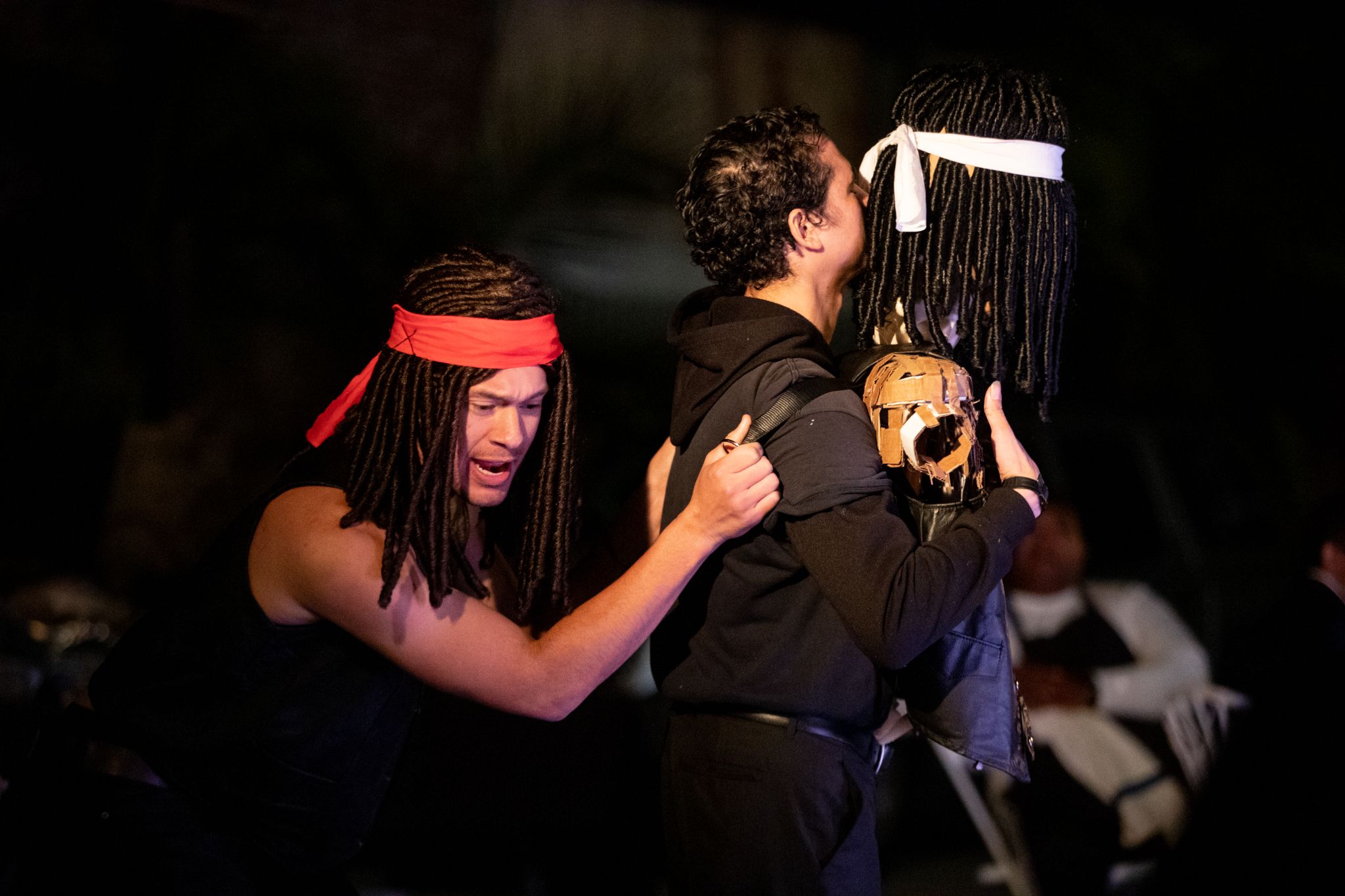Q&A: Edgar Arceneaux reveals caregiving, storytelling themes of play ‘Boney Manilli’

Actors perform with puppets on the stage of “Boney Manilli.” Written and directed by Edgar Arceneaux, the play will run Oct. 5-7 at the Roy and Edna Disney CalArts Theater. (Courtesy of Bailey Holiver)
“Boney Manilli ”
Oct. 5-7
Roy and Edna Disney CalArts Theater
$30
By Lex Wang
Oct. 4, 2023 7:09 p.m.
This post was updated Oct. 5 at 8:33 p.m.
“Boney Manilli” is retelling an age-old story from new perspectives.
Loosely inspired by the infamous scandal involving pop duo Milli Vanilli, Edgar Arceneaux’s “Boney Manilli” follows the tale of two brothers – one who has struggled to finish his play about the late-1980s group and another who hopes to adapt “Song of the South” into his own play – as they come to terms with their mother losing her memories. Set to premiere Thursday at the Roy and Edna Disney CalArts Theater in partnership with UCLA’s Center for the Art of Performance, the musical will explore the conditions of the modern political landscape.
Arceneaux spoke with the Daily Bruin’s Lex Wang on why he wrote the play and what he hopes to express through the production.
This interview has been edited for length and clarity.
[Related: Q&A: Tarell Alvin McCraney discusses his new position at the Geffen Playhouse]
Daily Bruin: What is “Boney Manilli” about?
Edgar Arceneaux: “Boney Manilli” is a dark comedy between two sons and a mom. At the heart of it, the two sons are both trying to tell a story before their mother forgets who they are – their mom is suffering from late-stage dementia.
DB: What are the key themes of “Boney Manilli?”
EA: Part of it is the relationship between the mother and the children, and how illness can change that power dynamic – sometimes in destructive ways. The other theme is the history of exploitation.
DB: What were your inspirations behind writing the play?
EA: Part of it is autobiographical, because my mother also suffered from the disease. (Personal experience) gives you a certain insight into the bookends of life and how vulnerable we can become when we start to lose control of not only our own bodies, but our minds.
As a matter of practice, I like to bring stories together that we don’t normally associate with being connected. In this case, the story of Rob (Pilatus) in Milli Vanilli, and how they were outed lip-syncing, there was a bigger story there that hasn’t been told. And I wanted to bring this story up: On one side, about forgetting who you are, and then on another side, about trying to get people to remember something but to remember it differently.
DB: What was your creative process in developing this play?
EA: I have told this play in four different ways – this is the fourth iteration, hopefully the final one – over the last six years. In this one, I really tried to tell it from the perspective of how people experience dementia. Sometimes, you can mistake your son for your dad or your sister for your mother. That confusion, I thought it was an interesting way to explore history because my story is covering about 150 years of time, and I thought that fragments and gaps and breaks were a good way to jump through these different stories. Because in many ways, the story is one that repeats itself over and over again.
We created all our own music for the show. All of the songs are super addictive. I tried to use the same insidious tactics that pop musicians use to make their songs popular. In some subtle way, I’m trying to manipulate my audience the same way that contemporary music manipulates us.
DB: What sets this play apart from other shows?
EA: We really bring the audience into the show. The way that we turn the show on the audience, they become active participants. I like to describe it as a piece of performance art inside of a play.
[Related: Nimoy Theater hosts glittering opening night with musical performances]
DB: What elements did you choose to use in the play, and why?
EA: The puppets are part of the surreal aspect of what the characters are going through. Two of them are going through levels of madness – one through dementia, the other one, (like) Alice in Wonderland slipping down a rabbit hole. Also the way that these authors, like Joel Chandler Harris, turn people into puppets.
DB: What do you want audiences to take away from “Boney Manilli?”
EA: I hope that they laugh, I hope that they cry. I hope that folks have a new understanding of the story of Milli Vanilli and what happened to them. For us to think about the end of our own lives and how we want to be taken care of, how we take care of others who are in need. Also, the complications of being a caregiver – a lot of the time, people don’t talk about how challenging that really is.

